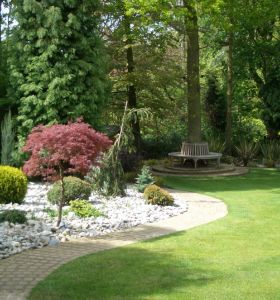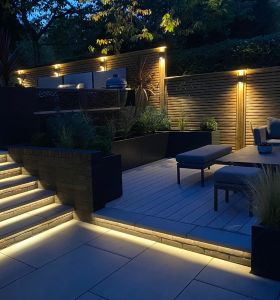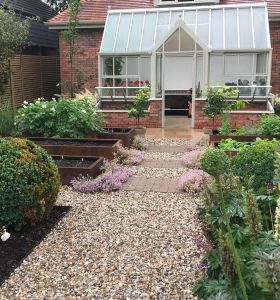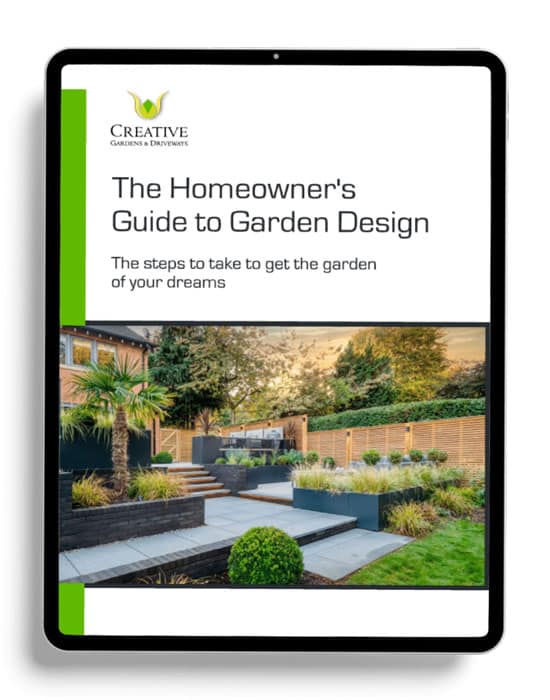Top 9 Garden Design Tips For Any Garden
Your garden should be an extension of your home – perfectly built for relaxing, entertaining and hosting. However, a lot of people do not feel this way about their own outdoor space because the design is lacking.
Redesigning your garden may seem difficult, but it does not have to be. Paired with professionals like our Creative Gardens & Driveways team and our wealth of garden design tips, you may find it easier than ever to create the garden of your dreams.
In this post, we are sharing the top 9 garden design tips to transform any outdoor space and help our clients create a space they can be proud of.
1) Assess Your Space
The first of our garden design tips, and the first step when redesigning your garden, is to assess your space. Take some time to truly evaluate your garden, not just how it looks but also it’s size, condition and climate. For example, note whether there are any slopes in the ground and how much sunlight the space gets, as this will play a big role in your future decisions.
The first step in our garden design service is to perform site assessments for our clients. This allows us to deliver bespoke care in each project, as we fully understand the needs of the specific landscape and what our clients want. By assessing the garden first, it becomes easier to plan the garden design and determine which methods will be best for you.
After all of your work redesigning your garden, you want to make sure it lasts and this will only be possible when you have considered the unique characteristics of your landscape.
2) Define The Purpose
Garden design can feel overwhelming, but an effective way to streamline the process is by considering the purpose of your outdoor space. Defining the purpose of your garden can help narrow down all future design decisions, as you will have a clear theme in mind.
The purpose of your garden can be as complex or as straightforward as you desire, as long as you are aware that this will influence the rest of the garden design tips offered. For example, having one clear purpose for the garden and designing a space suitable for this will be easier than a space split into separate zones with their own setting.
Nonetheless, the size and condition of your garden can help determine the purpose of the space but don’t be afraid to get imaginative. What would your dream garden be? Do you envision a calming, tropical oasis where you can lounge on a sunbed in the peace of your own company? Or are you seeking a more social escape, such as a garden complete with an outdoor kitchen and dining area, perfect for hosting friends and family at a moment’s notice?
Defining the purpose of your new outdoor space is essential before we can move on to any of the other garden design tips.
3) Choose A Focal Point
Every great garden design centres around a focal point that draws the eyes and adds visual interest to the space. There are countless options for a garden focal point, based on your budget, style and garden size, allowing for complete creativity with these garden design tips.
A focal point can be anything from an elegant water feature to a particularly interesting plant or shrub. Whatever you choose, having a central focus in the garden adds structure to the space and ensures harmony with the rest of the design without the space being too cluttered.
4) Work With Levels
Incorporating levels into your garden is one of the best garden design tips for smaller spaces, but it can be useful no matter what kind of landscape you are working with. Adding levels creates depth and structure, while also making the space visually interesting.
Instead of focusing all of your work on the ground, for example, just having plants and decorative items at floor level, consider incorporating levels such as raised planters, terraces or even additional structures like pergolas and trellises. This can be highly effective for smaller gardens where space is at a premium, but is also a great garden design too for larger landscapes too as it creates more visual interest without clutter.
These garden design tips are also incredibly useful if you have uneven surfaces in your garden, as they allow you to work with the natural slopes of the landscape and create a space that is truly unique to your home. Drawing the eyes upwards and having varying levels makes a space more interesting and avoids the threat of excess.
5) Pick Cohesive Colour Palettes
Colours are not just visually interesting, but they can also set the mood of your garden so need to be considered carefully. This is why one of our best garden design tips is to consider cohesive colour palettes and carefully consider the kinds of plants, flowers and decorative items being used across your garden. Colours of fences and hardscaping, such as pathways and patios, should also be considered as these all contribute to the overall mood of the space.
One of the most common colour palettes for garden designs these days is to focus on neutral shades. Whether you opt for cool or warm-toned hardscaping, this can be beautifully offset by the occasional pop of colour from plants or decoration.
It is a good idea to work with the existing structure of your home to determine the best shade of hardscaping, as you want to create a seamless blend of indoor and outdoor living. A unified colour palette of complementing colours creates an elegant, dignified environment that is certain to look good all year round.
If you want to create a more vibrant space then consider incorporating a range of colours. Contrasting colour palettes can create a truly engaging and dramatic environment, but it is not for everyone.
From bright flowers to coloured LED lights, there are many ways you can incorperate fun shades into your outdoor space to create a wild, engaging environment that the whole family can enjoy.
6) Accessibility And Flow
While this post is focused on garden design tips, your garden also needs to be functional as well as looking good. Functionality and accessibility are just as important as aesthetics in any successful garden design, and pathways play a big role in this. Especially if you have a large lawn area, pathways can prevent too much traffic across the grass without limiting access to the rest of the garden.
Pathways can help guide people through your garden, ensuring they remain on track. Paving can be enhanced with plants, flowers and outdoor lighting to ensure it serves both purposes of functionality and aesthetics.
Hardscaping can be incorporated to suit any outdoor space, with bespoke designs available from our team. For example, curved pathways which wind through the garden and lawn can be installed to soften the look of the landscape and create a sense of adventure.
7) Maximise Use With Garden Lighting
Outdoor lighting is one of the most effective garden design tips as it is also functional and attractive. Lighting is required to ensure your garden can be used and admired well after the sun goes down, and is required if you want to prolong your hosting occasions.
With outdoor lighting, whether lanterns, twinkle lights, or overhead spotlights, you do not have to cut the party short and can continue to enjoy your beautifully designed garden well into the evening.
There are countless types of garden lighting available, ensuring there is going to be something for everyone. It is recommended to combine both useful and purely decorative lighting for a cohesive garden design. For example, thoughtful illumination around stairs, pathways and patios keeps your garden accessible well into the evening. These functional elements can be complemented with decorative lanterns and candles around the dining area, twinkle lights draped over a pergola, or uplights against garden structures.
8) Carefully Curated Plants
No outdoor space is complete without some form of natural appeal, which is why planting plays a significant role in our garden design tips. However, incorporating plants, flowers, and shrubs into your garden requires more than simply grabbing the first things you see.
While it is important to plant things you enjoy looking at, there are other considerations to make too. This includes the condition and climate of your landscape, as this will determine whether the plants can grow in your garden, as well as the maintenance required. If you do not have a green thumb nor time to dedicate to developing one, then you will want to opt for low-maintenance plants throughout your garden design. This allows you to have an attractive, thriving landscape without much effort.
Plants such as succulents and evergreens are ideal solutions for these kinds of gardens, as they are hardy and easy to look after. Seasonal varieties are a great way to incorporate occasional bursts of colour and annual plants will return each year, so you can maintain the same visual appeal time and time again.
As well as offering visual appeal, plants can provide a complete sensory experience. The combination of textures and scents can offer more layers of interest to your overall garden design and should be paired with complementing plants to make the space cohesive.
For example, plants particularly fragrant varieties such as jasmine or lavender near seating areas or entrances so you can regularly enjoy the beautiful scents when spending time outdoors.
9) Design For You
No matter what garden design tips we offer, the most important thing is that your garden is for you and therefore should be a space that you enjoy. It does not matter what kind of design tips and features you use, if you do not like the finished result then it will have been for nothing.
When designing your garden, be selfish and think about yourself – what you like, what you want to do, and how you want your space to feel. It does not matter what anyone else thinks or recommends, as long as you enjoy your garden.
Create a space that is just for you, whether this is the entire garden or a corner fit with cosy seating, a fire pit, or pergola cover, to ensure that you get to spend time outdoors and enjoy your new garden design. After all of your hard work, you deserve it.
Conclusion
Redesigning your garden may seem difficult, but with these garden design tips and our expert help, it has never been easier.
Use these garden design tips to inspire you to create an outdoor space that you love. Take the time to consider your desires, as well as the needs of your landscape, and you will be able to create an environment that looks great, is functional, and totally fit for purpose.
To aid you on your journey, professionals like the team at Creative Gardens & Driveways are here to help. We offer a comprehensive garden design service, as well as landscaping solutions to bring your vision to life.
Contact Us Today
To get started on your garden transformation, reach out to the team today.






